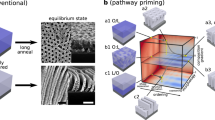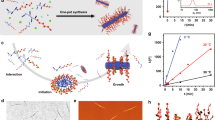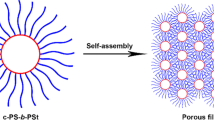Abstract
The spontaneous formation of nanostructured materials by molecular self-assembly of block copolymers is an active area of research, driven both by its inherent beauty and by a wealth of potential technological applications1,2,3,4. Thin films of block copolymers have attracted increasing interest, particularly in view of possible applications in nanotechnology5,6,7,8,9. Although much of the work has concentrated on block copolymers consisting of two components, the insertion of a third block greatly enlarges the structural diversity and allows incorporation of additional chemical functionality10,11. Here we describe a highly ordered hexagonally perforated lamella structure based on an ABC triblock copolymer thin film. By suitable choice of the three blocks a versatile structure is formed. The perforated lamella can serve as a lithographic mask, it can be chemically converted into an amphiphilic structure without losing its order, and after selective removal of one of its constituents it could be used as a responsive membrane. Intriguingly, the particular choice of the blocks ensures that the structure is formed irrespective of the chemical nature of the solid substrate. The experimental results are supported by mesoscale computer simulations.
This is a preview of subscription content, access via your institution
Access options
Subscribe to this journal
Receive 12 print issues and online access
$259.00 per year
only $21.58 per issue
Buy this article
- Purchase on Springer Link
- Instant access to full article PDF
Prices may be subject to local taxes which are calculated during checkout


Similar content being viewed by others
References
Bates, F.S. & Fredrickson, G.H. Block copolymer thermodynamics: theory and experiment. Annu. Rev. Phys. Chem. 41, 525–557 (1990).
Klok, H.A. & Lecommandoux, S. Supramolecular materials via block copolymer self-assembly. Adv. Mater. 13, 1217–1229 (2001).
Adrington, A.C. et al. Polymer-based photonic crystals. Adv. Mater. 13, 421–425 (2001).
Bockstaller, M., Kolb, R. & Thomas, E.L. Metallodielectric photonic crystals based on diblock copolymers. Adv. Mater. 13, 1783–1786 (2001).
Mansky, P., Chaikin, P. & Thomas, E.L. Monolayer films of diblock copolymer microdomains for nanolithographic applications. J. Mater. Sci. 30, 1987–1992 (1995).
Park, M. et al. Block copolymer lithography: Periodic arrays of similar to 10(11) holes in 1 square centimeter. Science 276, 1401–1404 (1997).
Cheng, J.Y. et al. Formation of a cobalt magnetic dot array via block copolymer lithography. Adv. Mater. 13, 1174–1178 (2001).
Jeoung, E. et al. Fabrication and characterization of nanoelectrode arrays formed via block copolymer self-assembly. Langmuir 17, 6396–6398 (2001).
Kim, H.-C. et al. A route to nanoscopic SiO2 posts via block copolymer templates. Adv. Mater. 13, 795–797 (2001).
Bates, F.S. & Frederickson, G.H. Block copolymers: designer soft materials. Phys. Today. 52, 32–38 (1999).
Krausch, G. & Magerle, R. Nanostructured thin films via self-assembly of block copolymers. Adv. Mater. 14, 1579–1583 (2002).
Mansky, P. et al. Controlling polymer-surface interactions with random copolymer brushes. Science 275, 1458–1460 (1997).
Thurn-Albrecht, T. et al. Overcoming interfacial interactions with electric fields. Macromolecules 33, 3250–3253 (2000).
Thurn-Albrecht, T. et al. Ultrahigh-density nanowire arrays grown in self-assembled diblock copolymer templates. Science 290, 2126–2129 (2000).
Giebeler, E. & Stadler, R. ABC triblock polyampholytes containing a neutral hydrophobic block, a polyacid and a polybase. Macromol. Chem. Phys. 198, 3815–3825 (1997).
Ludwigs, S. et al. Phase behavior of linear polystyrene-block-poly(2-vinylpyridine)-block-poly(tert-butyl methacrylate) triblock copolymers. Polymer 44, 6815–6823 (2003).
Magerle, R. Nanotomography. Phys. Rev. Lett. 85, 2749–2752 (2000).
Hajduk, D.A. et al. Stability of the perforated layer (PL) phase in diblock copolymer melts. Macromolecules 30, 3788–3795 (1997).
Knoll, A. et al. Phase behavior in thin films of cylinder-forming block copolymers. Phys. Rev. Lett. 89, 035501 (2002).
Huinink, H.P. et al. Asymmetric block copolymers confined in a thin film. J. Chem. Phys. 112, 2452–2462 (2000).
Tassin, J.F. et al. Kinetics of adsorption of block copolymers revealed by surface plasmons. J. Phys. Chem. 93, 2106–2111 (1989).
Fraaije, J.G.E.M. Dynamic density-functional theory for microphase separation kinetics of block-copolymer melts. J. Chem. Phys. 99, 9202–9212 (1993).
Fraaije, J.G.E.M. et al. The dynamic mean-field density functional method and its application to the mesoscopic dynamics of quenched block copolymer. J. Chem. Phys. 106, 4260–4269 (1997).
Sevink, G.J.A. et al. Dynamics of surface directed mesophase formation in block copolymer melts. J. Chem. Phys. 110, 2250–2256 (1999).
Segalman, R.A., Yokoyama, H. & Kramer, E.J. Graphoepitaxy of spherical domain block copolymer films. Adv. Mater. 13, 1152–1155 (2001).
Kim, G. & Libera, M. Morphological development in solvent-cast polystyrene-polybutadiene-polystyrene (SBS) triblock copolymer thin films. Macromolecules 31, 2569–2577 (1998).
Acknowledgements
We thank the Deutsche Forschungsgemeinschaft for financial support (SFB 481), and A. Knoll, G.J.A. Sevink, C. Abetz and M. Hund for help. A modified version of the MesoDyn Code for asymmetric boundary conditions was kindly provided by G. J. A. Sevink and A. V. Zvelindovsky. A.V. acknowledges financial support through the Humboldt Foundation and R.M. acknowledges financial support through the VolkswagenStiftung.
Author information
Authors and Affiliations
Corresponding author
Ethics declarations
Competing interests
The authors declare no competing financial interests.
Rights and permissions
About this article
Cite this article
Ludwigs, S., Böker, A., Voronov, A. et al. Self-assembly of functional nanostructures from ABC triblock copolymers. Nature Mater 2, 744–747 (2003). https://doi.org/10.1038/nmat997
Received:
Accepted:
Published:
Issue Date:
DOI: https://doi.org/10.1038/nmat997
This article is cited by
-
Synthesis of novel block polymers with unusual block sequences by methodology combining living anionic polymerization and designed linking chemistry
Journal of Polymer Research (2019)
-
Self-assembly Behavior of Symmetrical Linear ABCA Tetrablock Copolymer: A Self-consistent Field Theory Study
Chinese Journal of Polymer Science (2018)
-
Patterning of triblock copolymer film and its application for surface-enhanced Raman scattering
Chinese Journal of Polymer Science (2017)
-
Complex microstructures of ABC triblock copolymer thin films directed by polymer brushes based on self-consistent field theory
Nanoscale Research Letters (2014)
-
Photo-Degradation Study of CdTe Nanocrystals by Fluorescence Measurement
Journal of Fluorescence (2011)



